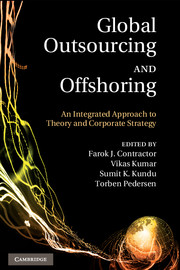Outsourcing
Outsourcing has become one of the key restructuring tools for companies seeking to boost their growth and business performance. As the outsourcing phenomenon has mushroomed, so a range of academic studies have sought to define and describe a unifying theoretical model. Outsourcing: Design, Process and Performance draws upon managerial, economic, sociological, historical and psychological perspectives to bring about an understanding of how outsourcing design and the outsourcing process feed into the performance of firms. Blending empirical insights from a range of international cases and large-scale statistical tests with existing theoretical perspectives, the author argues that a negative curvilinear relationship exists between outsourcing and firm performance. A critical analysis of current outsourcing strategies, together with a discussion of future trends, offers a new agenda for academic researchers and business managers alike.
- Draws on multiple social science perspectives to provide a thorough analysis of the various forms and stages of the outsourcing phenomenon
- Examines a range of international cases, leading to the proposition of a new relationship model between outsourcing and firm performance
- Provides a platform for future academic research on this important topic within business management
Reviews & endorsements
'This book offers probably the most comprehensive treatise on outsourcing strategy that exists today. What differentiates this book from others is that the author takes a serious look into various views on outsourcing strategy and offers an unbiased assessment of its short- and long-term performance implications. It is a must-read not only for academics but also for corporate executives in charge of outsourcing strategy.' Masaaki Kotabe, Washburn Chair Professor of International Business and Marketing, Temple University, Philadelphia
'Outsourcing was in danger of becoming over hyped, with an exaggeration of its benefits and neglect of its problems and shortcomings. Michael Mol has served the literature and business practice well by developing a more balanced view that takes into account both opportunities and benefits, as well as limitations and adverse effects. For example, he includes the social cost of outsourcing that has previously been ignored. His main contribution is the following. Reasonably, and convincingly, using both theoretical and empirical argument, he shows that firm performance is an inverse U-shaped function of the extent of outsourcing. There can both too little and too much outsourcing. The book is very helpful in showing how the trade-off between advantages and disadvantages works.' Bart Nooteboom, Professor of Innovation Policy, Tilburg University and member of the Dutch Scientific Council for Government Policy
'… I read this book with interest … It is well structured, well argued, and a compelling read.' Organization Studies
Product details
September 2007Hardback
9780521864107
236 pages
236 × 158 × 19 mm
0.494kg
7 b/w illus. 5 tables
Available
Table of Contents
- Figures
- Tables
- Acknowledgements
- 1. Outsourcing
- 2. What we know about outsourcing
- 3. A new perspective
- 4. The outsourcing process
- 5. Shifting the curve
- 6. Shifts of the curve
- 7. Managing outsourcing
- 8. Outsourcing research agenda
- 9. Future trends and conclusions
- Appendix
- References.




